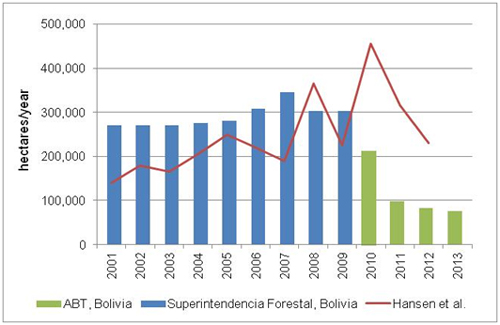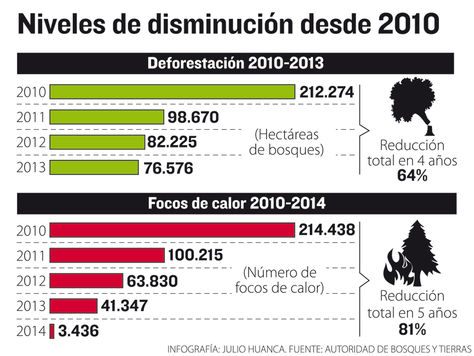Mission Accomplished or Too Good to be True?
by Lykke E. Andersen, INESAD
During the last decade, Bolivia had one of the highest per capita deforestation rates in the World (1). Apart from this being decidedly unkind to Mother Earth and exacerbating problems of wild fires, droughts and flooding in Bolivia, this also caused Bolivians to be among the biggest contributors to CO2 emissions in the World (approximately 11 t/CO2/person/year – more than almost all European countries and more than twice the global average) (2).

This was obviously a major problem in Bolivia, and at INESAD we have been working for several years on promoting policies to reduce deforestation. Thus, we should be thrilled by the recent news from ABT showing that Bolivia has reduced deforestation by 64% since 2010 (see Figure 1).
Figure 1: ABT reports sharp reductions in deforestation in Bolivia between 2010 and 2013.
Source: La Razon, 23 July 2014 (http://www.la-razon.com/sociedad/ABT-Bolivia-redujo-deforestacion-bosques-anos_0_2093790639.html#.U9I6T0RWunI.facebook).
But it almost seems too good to be true. I suspect that everybody working in this area are asking themselves: Can this really be true?
To shed some light on this question, in Figure 2 we compare official deforestation data reported by the Bolivian government (3) with independent deforestation data calculated by the Global Forest Change project at University of Maryland (4). While the two sources use different definitions of both forest and deforestation, both do indeed show a sharp drop in Bolivian deforestation rates since 2010.

Figure 2: Annual deforestation rates in Bolivia, 2001-2013.
Source: Author’s elaboration based on official deforestation data (3) and data from Hansen et al. (2013) processed by the Center for Global Development (4).
But otherwise, there is not much in common between the two data series. Indeed the correlation coefficient is negative (-0.29).
From the official data (the blue and green bars), the recent drop looks like a systematic and sustained reduction starting just about the time Bolivia decided to reject the international REDD+ mechanism (2010) and instead develop an alternative mechanism called the Joint Mitigation and Adaptation Mechanism for the Integral and Sustainable Management of Forests and Mother Earth. The drop was further supported by the Framework Law for Mother Earth (2012), which basically made deforestation illegal; by the increase in monitoring, enforcement and fines on illegal deforestation implemented by the Bolivian Authority on Forests and Land (ABT) in recent years; and by educational initiatives like Amazonia sin Fuego.
From the Hansen et al. data (red line), on the other hand, one gets the impression that there is a general upward trend in deforestation in Bolivia, with increasing random variation from year to year. One would need at least two more years of observations to be convinced that the recent drop really represents a sustained reduction in deforestation.
Which one to believe so far?
Personally, I would love the official data to be true. Just the climate change mitigation benefits of the reduced deforestation over the last three years would be staggering. Assuming a conservative damage value of USD 10 per ton CO2 emitted into the atmosphere, the global value of reduced carbon emissions in Bolivia in just three years would amount to more than USD 2.5 billion dollars (5).
Between all the institutions that have worked very hard to reduce deforestation in Bolivia over the last five years, including parts of the Bolivian Government, I don’t think the total investment amounted to more than USD 25 million. This means that the global social return to those investments has been at least 100 to 1. It doesn’t get much better than that.
But…. ABT needs to provide a lot more detail about how those official deforestation numbers were calculated. One press release with a few aggregate numbers is not enough. A systematic and comprehensive monitoring system with total transparency and access to the processed data is necessary to: a) convince us that it is really true, and b) to figure out what made it possible.
After all, there are not that many climate change mitigation investments in the world that yield a 100 dollar return to a 1 dollar investment in just a few years, so if we can understand how this happened and replicate it in other countries, we might just save the planet.
* Dr. Lykke E. Andersen is the Director of the Center for Economic and Environmental Modeling and Analysis (CEEMA) at the Institute of Advanced Development Studies (INESAD), La Paz, Bolivia.
Footnotes:
(1) UN-REDD Programme (2010) National Programme Document – Bolivia. http://www.unredd.net/index.php?option=com_docman&task=doc_download&gid=1685&Itemid=53
(2) Andersen, L. (2009) “Bolivia’s high CO2 emissions” http://inesad.edu.bo/developmentroast/2009/03/bolivias-high-co2-emissions/
(3) The first 9 years are the official numbers reported by the Bolivian Superintendencia Forestal for the 2010 FAO Global Forest Resources Assessment: FRA (2010) “EVALUACIÓN DE LOS RECURSOS FORESTALES MUNDIALES 2010: INFORME NACIONAL BOLIVIA” FRA 2010/025. http://www.fao.org/docrep/013/al461s/al461s00.pdf . The last 4 years are the numbers reported by ABT in Figure 1.
(4) Hansen, M.C. et al. (2013) “High-Resolution Global Maps of 21st Century Forest Cover Change.” Science 342: 850-853. The data was tabulated using a 25% tree cover threshold and kindly made available by Jens Engelmann and Jonah Busch at the Center for Global Development.
(5) Assuming a baseline level of deforestation of 300,000 hectares per year, the reduction in deforestation over the last three years amounts to just over 500,000 hectares. The average CO2 emissions from each hectare deforested is about 500 tCO2, so in total we have reduced CO2 emissions from deforestation by 250 million tons in just three years. Assuming a conservative value of USD 10 per ton CO2, this amounts to global benefits of USD 2.5 billion.








